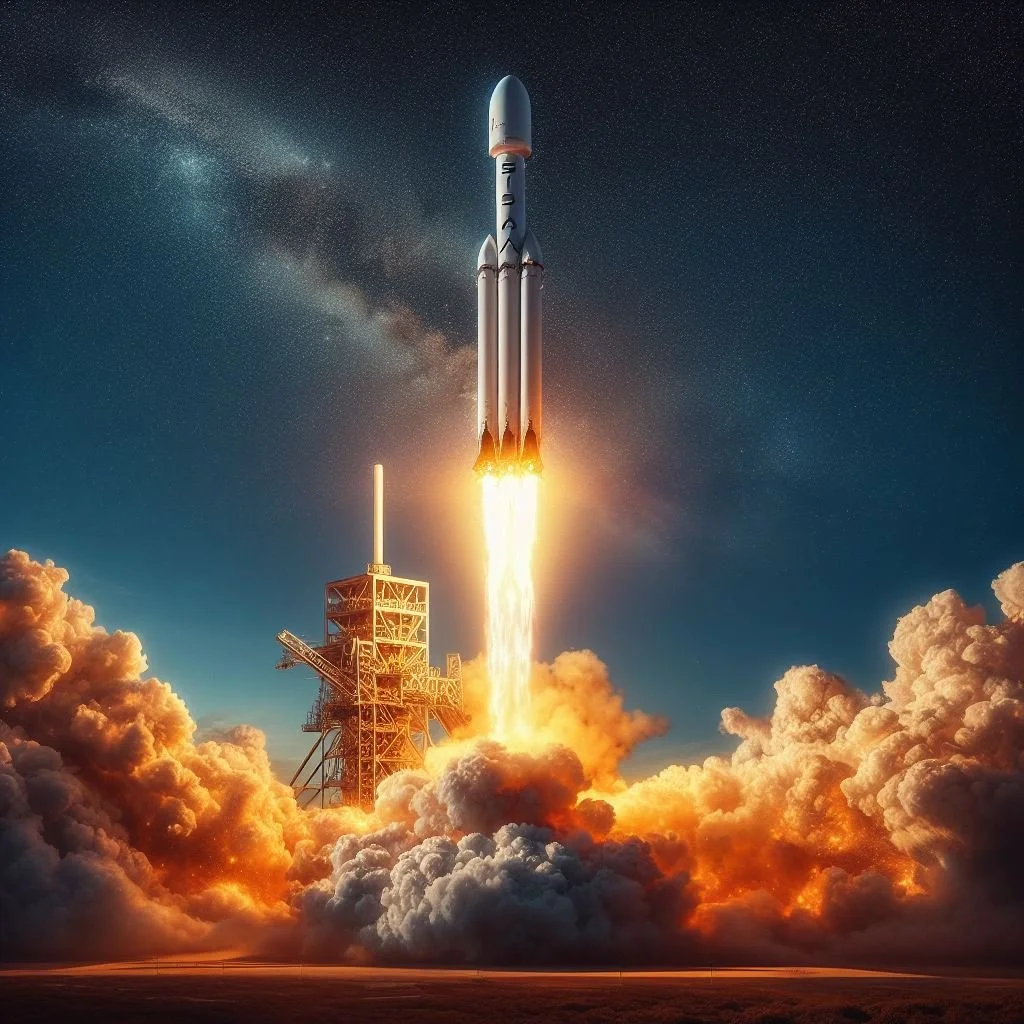Rocket Propulsion Technologies: Past, Present, and Future
Rocket propulsion has been essential to every milestone in space exploration, allowing humanity to escape Earth’s gravity, reach orbit, and go beyond. From the earliest chemical rockets of the mid-20th century to today’s advanced systems, propulsion technology has steadily improved, becoming more powerful, efficient, and reliable. These advances have not only made space access more common but have also opened new doors for deep space missions, satellite deployment, and commercial spaceflight.
Early propulsion systems, like those used in the Mercury, Gemini, and Apollo programs, relied on simple liquid and solid fuels. While effective, they had limitations in reusability and performance. Modern rockets employ more sophisticated engines, such as staged combustion cycles and vacuum-optimised nozzles, to boost efficiency and thrust. Reusable boosters and innovative systems like electric and hybrid propulsion are now becoming standard, significantly altering cost structures and mission planning.
Looking forward, next-generation technologies like nuclear thermal propulsion and solar-electric systems aim to revolutionise how we travel through the solar system. As the space industry grows, rocket propulsion will stay at the core of innovation, pushing us towards new frontiers and transforming what’s achievable in human and robotic spaceflight.
The Past: Foundations of Spaceflight
The story of rocket propulsion begins in the early 20th century, with visionaries and engineers pushing the boundaries of science and imagination. One of the key figures in this era was American physicist and inventor Robert H. Goddard, often called the "father of modern rocketry." In 1926, he launched the world’s first liquid-fuelled rocket, proving that such technology could produce thrust and support controlled flight. Though modest in size, Goddard’s achievement marked the start of a technological revolution that would eventually send humans to the Moon.
In the decades that followed, rocket development gained pace, mainly driven by military needs during World War II and the Cold War. The German V-2 rocket, developed under Wernher von Braun’s direction, became the first man-made object to reach the edge of space. After the war, von Braun and other scientists brought their expertise to the United States, where they played a crucial role in forming NASA and developing American launch vehicles.
The peak of early rocket propulsion came with the Saturn V, the enormous launch vehicle built for NASA’s Apollo program. Over 110 metres tall, Saturn V used powerful F-1 engines burning a mix of liquid oxygen (LOX) and refined kerosene (RP-1) in its first stage, and liquid hydrogen (LH2) and LOX in its upper stages. This incredible machine generated over 7.5 million pounds of thrust at liftoff and remains the most powerful rocket ever successfully flown. It was responsible for sending astronauts to the Moon between 1969 and 1972.
The early reliance on chemical propulsion systems laid a strong foundation for all future space missions. These engines demonstrated that large-scale, controlled combustion of propellants could lift spacecraft from Earth’s surface, placing them into orbit or sending them on interplanetary journeys. The lessons learned during this time, about staging, fuel efficiency, nozzle design, and guidance systems, still inform the design of modern rockets.
Ultimately, the achievements of the early space age, powered by chemical propulsion, did more than just launch satellites or spacecraft—they inspired the human imagination. These early technologies proved that spaceflight was not just possible but within reach, setting the stage for the extraordinary advancements to come.
The Present: Advanced Propulsion Systems
Modern rocket propulsion has advanced significantly since the early days of space exploration. Today’s systems are not only more powerful but also smarter, more efficient, and increasingly sustainable. At the forefront of this progress is the move towards reusable launch vehicles, which has transformed the economics of spaceflight. Instead of discarding multi-million-dollar hardware after each launch, companies now recover and reuse rocket stages, dramatically reducing costs and turnaround times between missions.
SpaceX has driven much of this change, with its Merlin engine powering the Falcon 9 and the Raptor engine propelling the next-generation Starship. These engines use advanced turbopump-fed systems, deep throttling capabilities, and robust design features that enable multiple re-flights. However, the trend toward reusability is spreading. Other companies around the world, including Blue Origin, Rocket Lab, and emerging national space programs, are developing their own reusable propulsion systems to stay competitive.
At the same time, hybrid propulsion, which combines elements of solid and liquid fuel systems, is gaining attention for its safety, simplicity, and control. Although not as powerful as purely liquid engines, hybrid systems are being explored for small launch vehicles and suborbital flights where reliability and lower costs are priorities. Advancements in solid and liquid chemical propulsion continue to improve thrust-to-weight ratios and efficiency. Modern materials, cooling techniques, and combustion methods have boosted performance, enabling rockets to carry heavier payloads and reach more demanding orbits. These improvements are crucial as space missions grow more complex, supporting everything from mega-constellations of satellites to lunar landers and interplanetary explorations.
Beyond launch systems, electric propulsion is increasingly becoming the standard for in-space manoeuvring. Engines like ion thrusters and Hall-effect thrusters use electricity, often generated by solar panels, to accelerate ions and produce thrust. Although the force generated is minimal, the efficiency is extremely high, making electric propulsion ideal for long-duration deep space missions and satellite station-keeping. NASA, ESA, and private firms are deploying electric propulsion in planetary probes, commercial satellites, and even proposed crewed missions to Mars.
Together, these technologies represent a new era of propulsion, one defined by sustainability, flexibility, and reusability. As space becomes more accessible, advanced propulsion systems are helping to lower the cost of entry, expand mission capability, and open the door to destinations previously beyond reach.
The Future: Innovations Ahead in Rocket Propulsion
The next generation of rocket propulsion is ready to change how we explore and operate in space. As we venture beyond Earth orbit towards deep space destinations like Mars, the Moon, and the outer planets, traditional chemical propulsion won't be enough on its own. Engineers and researchers worldwide are now working on developing advanced propulsion technologies that offer faster travel, greater efficiency, and more sustainable operations.
One of the most promising innovations is nuclear thermal propulsion (NTP). This technology uses a nuclear reactor to heat a propellant, such as hydrogen, which is then expelled through a nozzle to generate thrust. NTP offers substantially higher efficiency than chemical rockets, potentially halving the travel time to Mars. Quicker transit means less radiation exposure for astronauts and more efficient deep space logistics. NASA and other space agencies are actively researching NTP systems, with the first in-space demonstrations expected within the next decade.
Another major advancement is the expansion of electric propulsion, especially ion and Hall-effect thrusters. These systems produce thrust by accelerating charged particles via electromagnetic fields. Although the thrust is modest, their fuel efficiency is remarkably high, making them perfect for long-distance interplanetary missions, satellite positioning, and even deep space probes. They have already been successfully deployed on missions like NASA’s Dawn and ESA’s BepiColombo, and upcoming upgrades will boost their performance even further.
Beyond current physics, theoretical ideas such as antimatter propulsion and fusion-based drives are being explored in experimental settings. Although these technologies are still decades away from practical application, they could one day enable propulsion systems capable of reaching nearby star systems. Antimatter propulsion, in particular, holds enormous energy potential, providing thrust thousands of times greater than chemical fuels if production and containment challenges can be addressed.
Alongside performance-driven innovations, sustainability is also becoming increasingly important. New eco-friendly or "green" propellants are being developed to replace toxic chemicals traditionally used in spaceflight, such as hydrazine. These propellants not only minimise risks for ground crews and the environment but also enable more versatile storage and handling.
Together, these emerging technologies point to a bold and exciting future. With ongoing investment, international collaboration, and scientific breakthroughs, the next phase of propulsion could enable human exploration well beyond our current limits, safely, efficiently, and sustainably.
Benefits for New Zealand
As a rapidly emerging player in the global space sector, New Zealand is uniquely positioned to benefit from advancements in rocket propulsion technology. The country has already attracted international attention with a reputation for agile regulation, strong research institutions, and access to ideal launch conditions. The success of companies like Rocket Lab has placed New Zealand on the global stage, but the future holds even greater potential, particularly as propulsion systems evolve.
By actively investing in propulsion research and development, New Zealand can strengthen its role in high-value sectors of the space economy. Advances such as reusable launch systems, electric propulsion, and green fuels open opportunities for local innovation, enabling Kiwi engineers and scientists to contribute to cutting-edge solutions. Supporting these technologies domestically could decrease dependence on foreign systems and foster a self-sufficient ecosystem for small satellite launches and beyond.
Furthermore, the adoption and development of more efficient and environmentally conscious propulsion systems align well with New Zealand’s broader values around sustainability and environmental protection. As global pressure increases to reduce the carbon footprint of space activities, New Zealand can lead by example in promoting and implementing cleaner propulsion options.
Economic benefits are also significant. Investing in advanced propulsion can help grow high-tech manufacturing, create more STEM jobs, and attract foreign partnerships and funding. By focusing strategically on space-enabled services and launch capabilities, New Zealand can expand its presence in satellite deployment, space tourism, lunar transport, and other emerging markets.
Internationally, New Zealand’s involvement in propulsion innovation can bolster its diplomatic and scientific ties. Working with spacefaring nations on propulsion-related projects and research will boost its influence in global policy debates, especially on topics like sustainability, regulation, and responsible space activities.
Ultimately, propulsion technology is not only an engineering challenge but also a national opportunity. By embracing this frontier, New Zealand can establish itself as a leader in the next phase of global space activity, boosting economic growth, scientific discovery, and long-term strategic advantage.
Conclusion
Rocket propulsion has advanced considerably since the early days of space exploration, growing from simple systems of the 20th century into the highly sophisticated engines relied on today. From powerful chemical rockets that carried astronauts to the Moon to modern reusable boosters and electric thrusters enabling satellite constellations and deep space missions, propulsion technology has propelled humanity’s exploration of space. However, this journey is far from over.
The future holds even greater promise. Innovations like nuclear thermal propulsion, ion drives, and green propellants are broadening possibilities in spaceflight, enabling faster, safer, and more sustainable missions to the Moon, Mars, and beyond. These advancements are not only pushing scientific and exploratory boundaries; they are also reshaping the global space economy, creating opportunities for new players and fostering international collaboration.
New Zealand stands on the cusp of an exciting new chapter. With a growing space industry, supportive regulations, and proven launch capabilities, the country is well-positioned to lead the next wave of propulsion innovation. By investing in research, fostering local talent, and forming global partnerships, New Zealand can shape the future of sustainable space access and exploration.
As the world explores further into the cosmos, propulsion remains crucial to uncovering its secrets. For New Zealand, it presents both a challenge and an opportunity—a chance to contribute meaningfully to one of the most transformative frontiers of our era.


